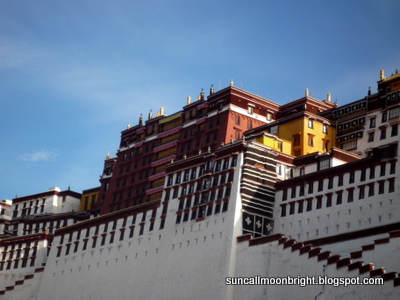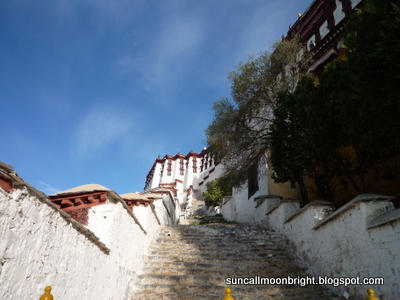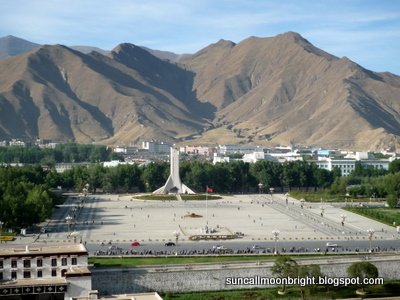View the previous post here or return to the trip index here.
03 Jun 2009
Finally, we were are the highlight of our trip. Woke up early in the morning to ascend the steps to Potala Palace. We had to reach the entrance of the palace by 9am as we only had an hour inside and the timings are pre-arranged. This was no easy feat with 67% sea-level oxygen. Thankfully it was morning and we were spared the penetrating sun. Lhasa is also known as the city of the sun for having one of the most number of hours of sunlight in a year. Our bus took us to the east gate where everyone enters. When we arrived, Tibetans devotees were already encircling the hill on which the palace is on. By circling in a clockwise fashion, they believe that they are accumulating merits for their next life, much like how mantras are spun in clockwise fashion as well.
Map of the Potala Palace and the People's Square in Lhasa. Blue route maks our entry from the eastern gate and up to the palace.
Red route, our path out of the palace to the People's Square. The palace is built on a hill with a large courtyard in front where
the heart of the city used to be. Devotees were circling the entire hill the palace sits on. This is the end point of many pilgrimages
that the locals undertake once in a lifetime, prostrating from their home town all the way to here -- a process that spans a few years.

A stone at the entrance of the eastern gate states that this is a UNESCO World Heritage site.

The first glimpse of the Potala Palace through the gate
 .
There are some over 1000 rooms in there!
.
There are some over 1000 rooms in there!

Close-up of the Red Palace where most of the important halls are.

They even have themed dustbins


A tavern! I vaguely remember they were saying that the playful Sixth Dalai Lama, being the most unorthodox, used to meet his friends here

Looking up at the arrays of windows of the White Palace that mostly houses living quarters for the lamas. The white is made with some mixture of milk that they have to splash down the walls ever now and then for maintenance

The daunting steps, walk, breathe, rest, walk breathe, rest...


The view of the peoples square as we ascended the steps of the palace, notice the barren brown mountains that surround Lhasa, a far cry from the lush greenery in Nyingchi.

A closer look at the arrays of windows neatly lined

Finally an entrance. We were at the top. Beyond this section is a courtyard of the White Palace

Aiks! More steps inside

Paintings adorn the walls

These should be made with crushed minerals mixed with animal material that is guaranteed to retain its colour for a hundreds of years

The courtyard where the entrance to the White Palace is. The White Palace mainly contains the living quarters and audience halls of the Dalai Lama. To the left of the courtyard is the toilet where one can send waste down seven stories to a pit filled with what looks like a few hundred years of human waste product.
To the right came the delightful sound of singing. Seems like some Tibetan women labourers were compacting mud and singing to keep in step. Tibetans are known as a musical people. The mud should be used for maintenance of the palace walls

The holographic entrance ticket makes a good souvenir. Too bad no pictures are allowed inside

We visited the diplomatic halls and living quarters of the Dalai Lama before reaching the rest area where a souvenir shop sells good books containing pictures and descriptions of most of the important venues within the palace

Next, we left the rest area and headed to the Red Palace where the stupa tombs of many of the previous Dalai Lamas are. These golden stupas were huge and encrusted with precious stones, mostly ancient corals from the ancient sea that once covered the land. The better the reign of a Dalai Lama, the richer they were and the bigger his stupa. For comparison, here

 is an example of a golden stupa taken previously at Ganden Monastery.
The largest in Potala Palace is more than ten times bigger than this!
is an example of a golden stupa taken previously at Ganden Monastery.
The largest in Potala Palace is more than ten times bigger than this!
 is an example of a golden stupa taken previously at Ganden Monastery.
The largest in Potala Palace is more than ten times bigger than this!
is an example of a golden stupa taken previously at Ganden Monastery.
The largest in Potala Palace is more than ten times bigger than this!

After nearing the exit of the Red Palace, they were hurrying us out of the place as our one hour inside was nearly up. We began our slow descend

I was shocked to see that they actually allowed cars up here. Perhaps its because the present form was completed in 1694 CE, making it only a couple of hundred years old and far from crumbling.

A look at the golden roof on the Red Palace

Further down we went along the palace walls

Outside, it was getting hot and the devotees were still circling the palace
Some walk, some prostrate as they walk. Some bring their pet dogs along as well as they believe that even if the dog has no idea what it is doing, it is accumulating merit for its next life.

An array of manni wheels outside waiting to be spun

Crossing the road, we came to the People's Square of Lhasa. Every major city has one of this. A huge monument and the PRC's flag is flown here.

Panorama of the Potala Palace from the People's Square, we will be returning at night to take night photos


A white stupa containing scripture is place right in the middle of the road, flanked by two other stupas. Its purpose? For Feng Shui. The original version of the Potala Palace was built in 637 by King Songtsän Gampo to welcome Tang princess Wencheng that was betrothed to him. Being proficient in Feng Shui, she realised that the Dragon Vein (important line that should not be broken) of Lhasa was disrupted by the road in front of the palace hill. To reconnect the flow, the stupas were placed to relink the line as seen from the top (yellow line) below.
The reconnected Dragon Vein using the stupas

A last look at the Potala Palace before we left
Having spent a tired morning climbing and visiting the Potala Palace, we left for lunch. Next, we will be visiting the Jokhang Monastery, the first Buddhist temple in Tibet built to celebrate King Songtsän Gampo's marriage to Tang princess Wencheng.
View the next post here. Return to the trip index here.
View the next post here. Return to the trip index here.
No comments:
Post a Comment